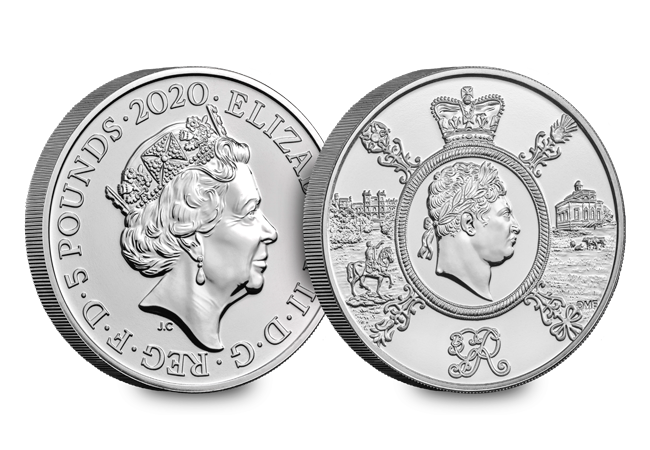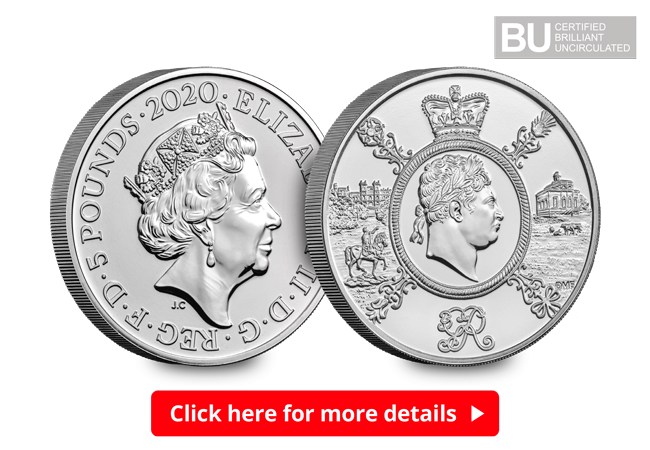Posts Tagged ‘Coin collection’
George III and the coins celebrating Britain’s longest reigning king
The 2020 George III £5 was issued as part of the Annual Coin Set on the 1st January and today the coin has been individually released.
King George III was the first king of the United Kingdom (which was officially formed in 1800) and to this day remains the longest reigning king in British History, reigning for an astonishing 59 years.
Throughout his reign, Britain fought in wars against France and America and from these wars the country emerged as a world power.
And so, in this anniversary year marking 200 years since his death, it seems only fitting that a brand new United Kingdom George III £5 coin should be issued.
2020 King George III £5 Coin
This is the first time George III has been celebrated on modern UK coinage and the stunning design explores the multifaceted nature of Britain’s longest reigning king.
Designed by renowned Royal Mint designer, Dominique Evans, the famous Bull’s Head portrait of George III is shown in a crowned cartouche, with the royal residence and his place of death, Windsor Palace, to the left and the King’s Observatory, which was founded by King George, to the right.
Click here to secure this coin for your collection!
Our Top Three George III Coins
But of course this is not the first time that King George has featured on UK coinage…
Throughout his reign from 1760 – 1820, the portrait of the king featured on the obverse design of Britain’s circulating coins.
We’ve taken a look at what we feel are three of the most interesting coins issued during his reign and the stories behind them.
1819 Sovereign
The very first gold Sovereign was struck during Henry VII’s reign in 1489, when the king ordered The Royal Mint to produce “A new money of gold.”
Originally Sovereigns were circulating coins accepted in Britain and elsewhere in the world, however it is now a bullion coin and is sometimes mounted in jewellery.
Many recent Sovereigns feature the well-known design of Saint George and the Dragon on the reverse, along with the initials (BP) of the designer, Benedetto Pistrucci.
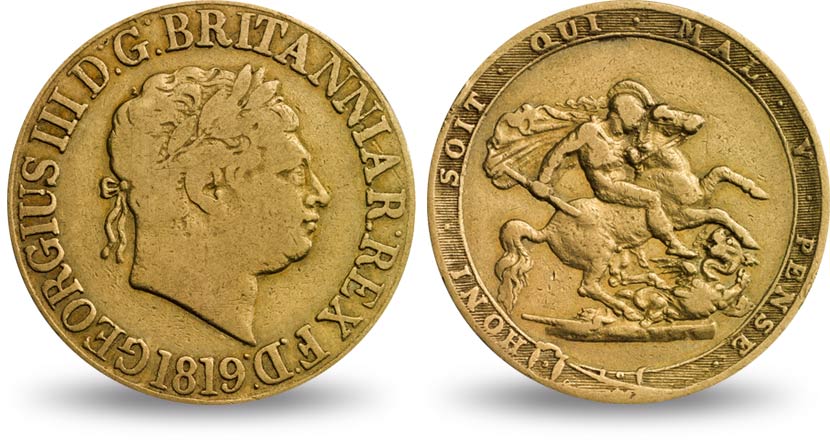
Now you might have heard of the 1819 Sovereigns already, and that’s because these coins are renowned for being exceptionally rare.
Remarkably, only 3,574 Sovereigns were minted during 1819 – struck on five separate occasions, between August and November 1819.
These coins were minted using gold provided by private merchants.
200 years after they were struck, it’s thought that potentially only ten of these Sovereigns are known to still exist.
Unsurprisingly, these coins sell for astonishing prices at auction, with the highest quality 1819 Sovereign known to exist achieving a price of £186,000 in 2013.
Cartwheel Penny
During the 18th century, the practice of melting down official copper coins and making lightweight forgeries had become so widespread that it prompted industrialist Matthew Boulton to offer a solution.
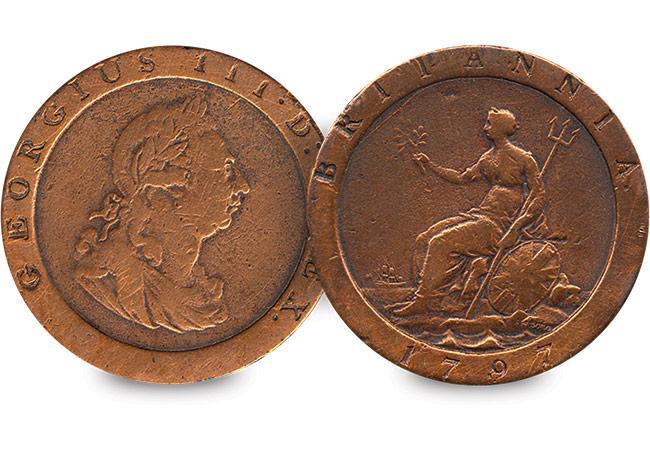
He proposed that each coin should actually be made to contain its value in copper, the quality should be improved by using a retaining collar during striking (to give a perfectly round coin) and thick raised borders would prevent them wearing so easily.
In 1797 Boulton was awarded a contract to supply 480 tonnes of pennies, each weighing one ounce and these were the very first British coins to be minted by steam power.
The George III Cartwheel Penny was also Britannia’s debut appearance on the penny – a position she held until decimalisation in 1971.

Because of their large size, Boulton’s coins soon earned the nickname ‘cartwheels’.
It is highly unusual for a low denomination to have such a substantial size and weight, and unsurprisingly they are in high demand from collectors for their status as Britain’s heaviest ever penny.
Eighteen Pence
In 1797, after a failed French invasion caused financial panic, British gold and silver coins disappeared from circulation, hoarded out of fear.
With so much coinage withdrawn from circulation, The Royal Mint found itself in a vulnerable position with a limited ability to issue coins.
Incredibly, this lead to the extremely unusual situation where the Bank of England acted as a substitute for The Royal Mint by issuing an emergency currency.
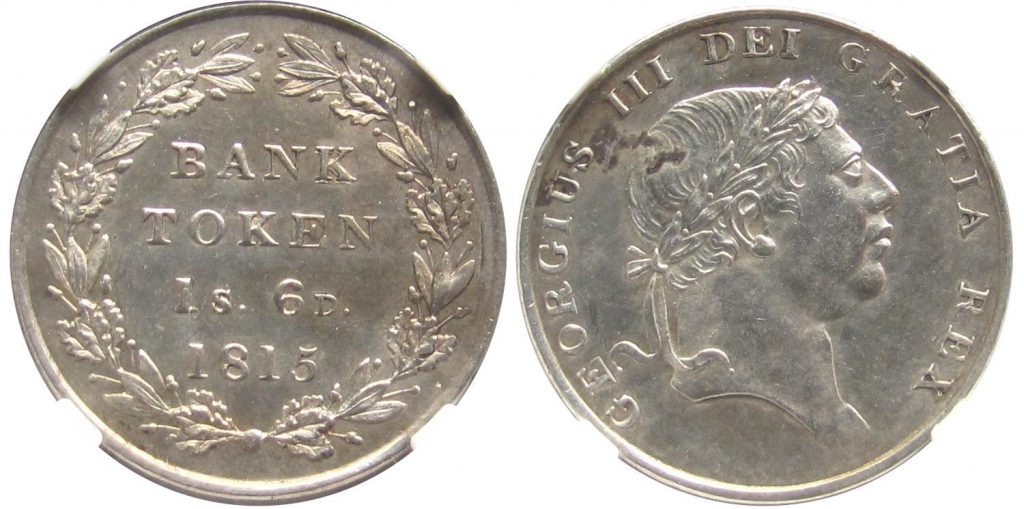
Technically speaking, these emergency issues were not coins but tokens.
This is also the reason why they issued very unusual denominations, including the eighteen pence piece.
These tokens were issued for just 7 years until they were eventually withdrawn from circulation in 1817, by which time a massive silver recoinage had been undertaken.
So now you know the stories behind some of the most acclaimed coins issued during the reign of George III, how does the brand new 2020 £5 coin compare? And will you be adding it to your George III collection?
Secure your 2020 George III £5 Coin
The 2020 George III £5 Coin is now available to purchase individually in superior Brilliant Uncirculated quality.
First look: New Royal Mint coin designs for 2020!
Happy New Year and Happy New Coins Change Checkers!
We can’t wait to reveal to you the new 2020 coin designs and I’m sure you’ll agree that there are some really fantastic coins to look forward to.
So let’s kick off the year with the coins we’ve all been waiting for, the 2020 Annual Set…
Team GB

We all love a 50p, and in this year’s Annual Coin Set The Royal Mint have issued a brand new 50p coin to support Great Britain in the Tokyo Olympic Games.
Designed by David Knapton, the 2020 Team GB 50p features symbols depicting individual Olympic sports accompanied by the Olympic Rings, the Team GB logo, the inscription ‘TEAM GB’ and the date ‘2020’.
The Olympics are an undeniably popular subject and for many the 2012 Olympic 50p series marked the start of their passion for change collecting.
In 2016 a Team GB 50p was issued to support Great Britain’s efforts in Rio and this was thought of by many as the 30th Olympic 50p, but with a new 2020 Team GB coin now being issued, could this be the 31st Olympic 50p?
We certainly love the design and I’m sure Change Checkers will think it’s a real winner too!
2020 Agatha Christie £2

English detective novelist Agatha Christie published her first novel, ‘The Mysterious Affair at Styles’ in 1920 and now, 100 years later, a £2 coin has been issued to commemorate her work.
Her 1920 novel introduced one of Britain’s best-loved detectives Hercule Poirot, who became a long-running character in Christie’s work, featuring in 33 novels and 54 short stories!
This coin has been designed by David Lawrence and features a nearly completed jigsaw puzzle with the final piece ready to be inserted, and the inscription ‘1920 100 YEARS OF MYSTERY 2020′.
Following the popularity of UK coins celebrating great British writers, such as the Jane Austen £2, Sherlock Holmes 50p, Charles Dickens £2, the Beatrix Potter 50ps and more, we’re sure that this new coin is bound to prove a real hit with collectors.
2020 75th Anniversary of VE Day £2

The next coin in the 2020 Annual Set marks an incredibly poignant anniversary, commemorating 75 years since VE Day and the end of the Second World War.
Victory Day in Europe celebrates the Allies of World War II formally accepting Nazi Germany’s unconditional surrender of its armed forces on the 8th May 1945, marking the end of the war.
Dominique Evans‘ design features a woman holding a newspaper aloft in crowd of celebrating people, set against a backdrop of the word VICTORY.
The edge inscription reads ‘JUST TRIUMPH AND PROUD SORROW’ which is incredibly fitting for a coin which marks such a pivotal moment in British history.
2020 Mayflower £2

2020 marks the 400th anniversary of The Mayflower’s voyage from Plymouth, England to the ‘New World’ in 1620.
This voyage saw over 100 Pilgrims and around 30 crew spend two treacherous months at sea, battling against the North Atlantic wind as they journeyed to America to establish the first permanent New England colony by signing the Mayflower Compact.
Designed by Chris Costello, the Mayflower £2 shows the ship upon a rough sea, with a guiding star in the night sky and the edge inscription ‘Undertaken for the glory of God’.
Excitingly for collectors, this is not the first time that The Mayflower has appeared on a £2 coin, as a similar design actually featured on the 1994 trial piece, which often sells for well into three figures on the secondary market!
2020 George III £5

This year marks the 200th anniversary since the death of George III, King of Great Britain and Ireland.
George’s life and reign were longer than any British monarch before him, although due to his deteriorating health during the last 10 years of his life, his eldest son George IV ruled as Prince Regent.
To celebrate the life of George III, The Royal Mint have issued a new £5 coin designed by Dominique Evans.
The coin features the portrait of King George III in a crowned cartouche at the centre of the coin, with his Royal Cypher below, floral emblems of the United Kingdom and scenes associated with his life from Windsor Castle and the Kew Observatory.
The announcement of the new annual coins is always an exciting moment for Change Checkers, particularly when the anniversaries are as significant as these.
Do you have a favourite coin from the set? Let us know in the comments below!
Own the 2020 Commemorative Coin Set
If you can’t wait to find these coins in your change, be one of the first to own the complete set!
World Coins struck by The Royal Mint
It’s common knowledge among Change Checkers that The Royal Mint strikes all the coins in the United Kingdom – and has done for centuries.
But what may come as a surprise to many collectors is The Royal Mint has historically struck coins for a variety of countries around the world!
Currently, outside of the UK, The Royal Mint provides services for over 60 different countries, including New Zealand and many Caribbean nations.
In the past, The Royal Mint has struck coins for North and South America, Africa and the Middle East!
In this blog, we take a look at our Top Five most interesting world coins struck by our very own UK Royal Mint and the stories behind them.
“From Norway to New Zealand, from Bermuda to Brunei, coins have been struck at The Royal Mint for countries all over the world.”
– The Royal Mint Museum
New Brunswick 1861 Half-Cent
Across the 18th and 19th centuries The Royal Mint, which was then based in London, minted several coins for North American states and the Caribbean.
Interestingly, in 1861 a half-cent coin, made of bronze, was minted for New Brunswick. More than 200,000 of these half-cent coins were struck, even though the denomination wasn’t actually needed.
It is said these coins were struck as a misunderstanding at The Royal Mint (that’s quite a misunderstanding!) and the majority of these were melted down. However, there has been reports that a lucky few coins have survived!

Norway 1942 25 Aurar
Many Change Checkers might be familiar with some of the coins struck by the UK Royal Mint throughout the Second World after reading our blog featuring coins struck in the UK for Iceland.
In addition to this a coinage was undertaken in the Second World War for the Norwegian government in anticipation of the country’s liberation from occupying forces.
Made out of Nickel-Brass and shipped to Norway ready for their liberation, this could have been one of the most exciting Norwegian coins in circulation.
However, the coin was never issued and the large majority of these were returned to The Royal Mint a few years later and melted down.

Nigeria 1959 Shilling
This Nigerian Shilling was made out of Cupro-Nickel, the same composition we are familiar with on modern United Kingdom 50 pence coins.
With an order of more than 1,000 million pieces for this new, distinctive Nigerian coinage, this is by far the largest international coin order The Royal Mint had ever received – quite the honour!
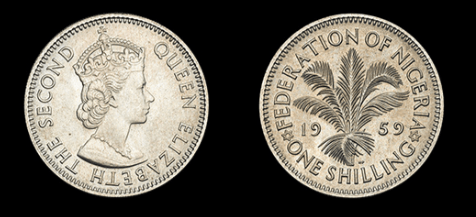
Hong Kong 1863 Mil
Introduced in 1863, the Hong Kong Mils were the first-ever perforated coins to be produced at The Royal Mint.
Perforated coins usually refer to coins which have a hole punched through the middle.
To date, although The Royal Mint have produced this style of coins for several other nations including East Africa, the United Kingdom has never had a perforated coin in their tender.

Australia 1951 Penny
Demand for Australian coinage in 1951 exceeded the capacity of the Brand Mints in Melbourne and Perth, and so the UK Royal Mint was approached for assistance.
Interestingly, the Australian coinage pieces struck in London are distinguishable by the addition of the tiny letters ‘PL’ which recalls a mintmark used by the UK Mint in Roman times.

So, there we have it! Our Top Five most interesting coins struck by the UK Royal Mint for countries around the world!
These coins tell quite the story of The Royal Mint’s long and important history in world coinage.
If you have any exciting coins from around the world or stories you’d like to share, let us know in the comments below!
If you’re interested in coin collecting, our Change Checker web app is completely free to use and allows users to:
– Find and identify the coins in their pocket
– Collect and track the coins they have
– Swap their spare coins with other Change Checkers
Sign up today at: www.changechecker.org/app

